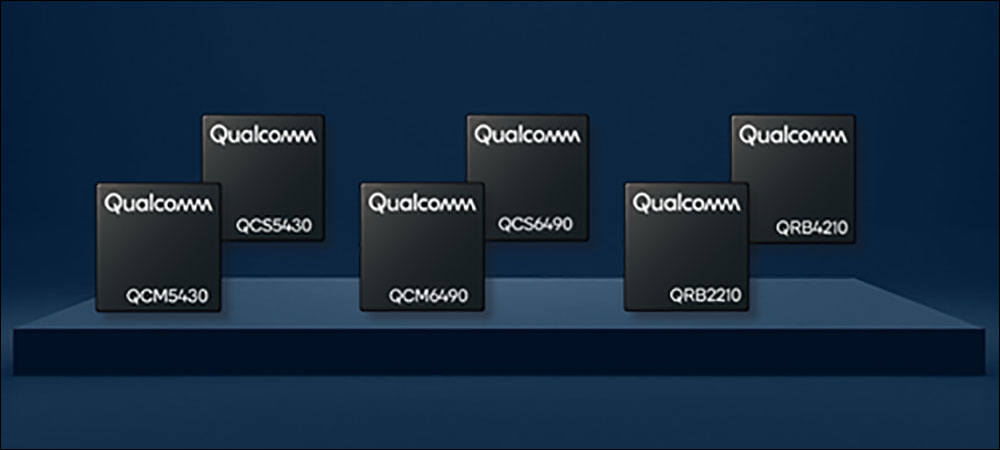RFID Journal LIVE! 2023 will feature end-user companies discussing RFID’s use in various industries, as well as exhibitors offering tagging solutions for multiple applications. To learn more, visit the event’s website.
- IoT Processors for Multiple Operating Systems
- Robotics Platforms with Artificial Intelligence
- Internet of Things Accelerator Program
Qualcomm Technologies has announced a series of integrated 5G Internet of Things (IoT) processors that support four major operating systems. The company has also introduced two robotics platforms, as well as an accelerator program for IoT ecosystem partners. These products, according to the company, are intended for manufacturers working with devices at the connected edge. The use of connected, intelligent and autonomous devices is growing rapidly, Qualcomm reports, and businesses require a reliable source of control and connectivity technology for their devices.
IoT Processors for Multiple Operating Systems
The company has upgraded its QCS6490 and QCM6490 system-on-chip processors, used for a range of IoT applications, to support four major operating systems. Both models can run Linux, Ubuntu and Microsoft Windows IoT Enterprise, in addition to Android systems. These processors offer 5G support for connectivity and geolocation for connected camera devices like dashcams, as well as edge boxes, industrial automation equipment and autonomous mobile robotics.
Qualcomm’s QCM5430 and QCS5430 processors are software-defined and can be scaled across IoT devices and deployment configurations for visual environments. This, according to Qualcomm, affords original equipment manufacturers the flexibility to choose between premium, preset or customized feature packs, then upgrade to support their own needs or provide customer upgrades. These processors support up to five vision sensors inputs, video encoding at up to 4K30, and machine-vision requirements with low-power and edge-AI processing. The edge AI can switch to cloud processing for handling multiple camera connections, as well as different response times and power efficiencies, and the processors support enterprise-grade on-device security.

Qualcomm offers preset platform packages known as QCM5430 and QCS5430 Feature Packs 1 and 2, offering high connectivity. Wi-Fi support includes 802.11ax (Wi-Fi 6E), with transmit speeds of up to 3.6 gigabits per second, as well as other enhancements for reduced latency, increased responsiveness, and handoffs in dense mesh environments such as hospitals and warehouses. The connectivity suite on the QCM5430 processor includes a 5G modem that supports millimeter-wave connectivity for fast data and precise geolocation.
Wired connectivity options start with a single USB 3.1 port and 1 PCIe port, and they can be configured for up to two PCIe ports and a 4K60 display port, among other options. Feature Pack 2 comes with increased CPU performance and interface support. Customers can choose from scalable and upgradable options as part of the QCM5430 and QCS5430 Custom Feature Pack, with support for up to 4K 60-frame-per-second video and up to Triple ISP camera functionality.
Robotics Platforms with Artificial Intelligence
Robotics companies can create robotics and IoT products with Qualcomm’s Robotics RB1 and RB2 platforms, powered by the company’s QRB2210 and QRB4210 processors. Both platforms are designed for smaller devices and lower power consumption, Qualcomm reports. They offer general-compute and AI-focused performance and communications technologies, with built-in machine-vision support for up to three cameras, providing onboard intelligence to meld this data with sensors for autonomous navigation and other applications.
The RB2 platform’s feature set is built on that of the RB1, with upgraded compute and GPU power and a dedicated AI accelerator that doubles the processing capability of the RB1, Qualcomm reports. This allows it to perform real-time, on-device AI, machine learning, detection, classification and environmental engagement. It can support cameras with up to 25 megapixels of resolution, and it has upgraded security features including a secure DSP and UI. The RB2 offers support for additional peripheral standards, such as UFS2.1, GPIO and UART.
The platforms support current and emerging connectivity standards, Qualcomm notes, including wired connections (USB 3.1 type-C for interconnects, and EMMC v 5.1 and SD3.0 for storage) and wireless connectivity via Wi-Fi, LTE or 5G. The RB1 and RB2 platforms and associated development kits will be available from Thundercomm. Qualcomm’s other robotics solutions includes the RB3, RB5 and RB6 platforms. These platforms are deployed in various industries, and the first helicopters to fly on Mars were controlled by a Qualcomm robotics and drone platform in 2021.
Internet of Things Accelerator Program
In addition, Qualcomm has launched an IoT accelerator program to propel the business success of IoT ecosystem partners engaged in transforming industries, business models and experiences. According to the company, the program brings together embedded hardware designers, independent software vendors, independent hardware component vendors, systems integrators and original design manufacturers equipped to accelerate digital transformation based on Qualcomm’s technologies.
According to Dev Singh, Qualcomm Technologies’ VP of business development and head of building, enterprise and industrial automation, the accelerator program pairs the company’s technologies with an ecosystem of expertise and solutions. The program is expected to drive innovation and time to value, he says, from retail to energy and utilities, and from tracking technologies to logistics and robotics.
“Our latest innovations,” Singh said in a prepared statement, “including the new robotics platforms and upgraded IoT processors, alongside the new Qualcomm IoT accelerator program, are designed to deliver greater support, expertise and access to robust technologies to an even broader range of builders and developers who play an important role in scaling intelligent edge devices.”

